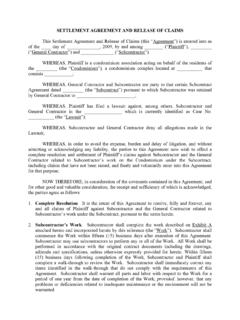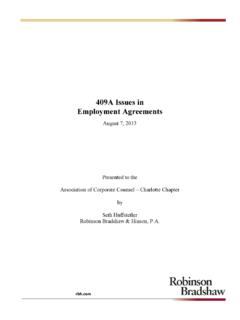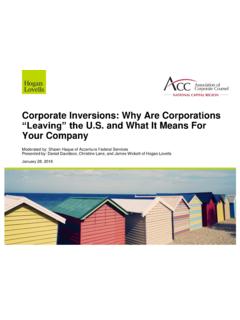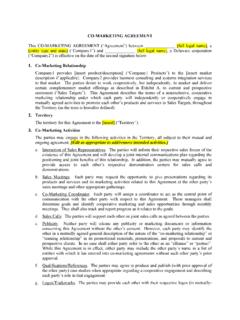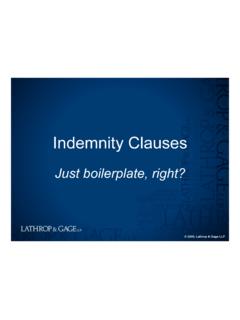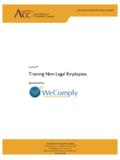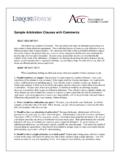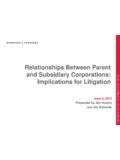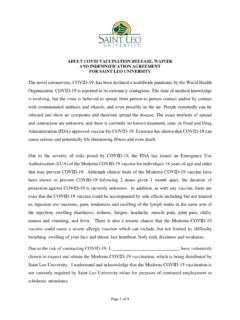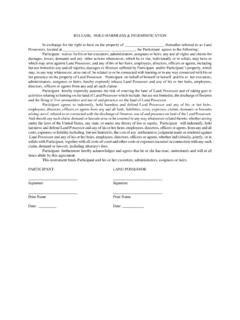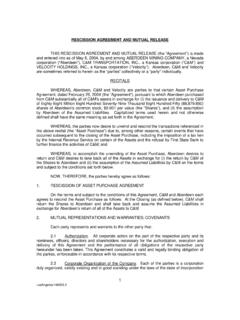Transcription of Defense and Indemnification Provisions: Lessons Learned ...
1 Defense and Indemnification Provisions: Lessons Learned from LitigationACC NATIONAL CAPITAL REGION CORPORATE LAW FORUM PRESENTATION: Panelists2C. Bryan WilsonPartnerWilliams & Connolly Mason SahariaPartnerWilliams & Connolly S. CampbellDeputy General Counsel Head of LitigationCoStar General Principles Specific Topics Negligence Exculpatory/Limitation of Liability Provisions Duty To Defend Attorneys Fees Exceptions and Special Cases Lessons for Drafting Indemnification and Defense Provisions Lessons for LitigationTable of Contents3 In general terms, indemnity is an obligation by one party to make another party whole for a loss, damage, or liabilitythe other party has incurred. The party obligated to pay is the indemnitor. The party entitled to Indemnification is the indemnitee. The obligation to indemnify another may arise by contract or by common law.
2 The purpose of indemnity provisions is to pre-determine how potential losses incurred during the course of a contractual relationship will be distributed between the potentially liable parties. Estes Express Lines, Inc. v. Chopper Express, Inc., 273 Va. 358, 366 (2007). Indemnification typically involves reimbursement for a third-party claim against the indemnitee. Indemnification may, however, cover other kinds of losses. First-party claims Regulatory fines, Principles of Indemnification and the Duty to Defend4 Duty to defend The duty to defend is distinct from and broader than the duty to indemnify. The duty to indemnify arises only once loss, damage, or liability has been incurred. The duty to defend, by contrast, arises when a claim has been made that could potentially result in loss, damage, or liability.
3 Exculpatory or limitation-of-liability provisions An exculpatory provision governs liability as between the two parties to a contract. One party releases the other party from liability to the first party for specific conduct. Although exculpatory provisions and Indemnification provisions are different, courts sometimes apply similar principles in construing and/or determining the enforceability of Principles (cont.)5 Indemnification is distinct from guaranty and surety contracts. In a guaranty contract, the guarantor promises to pay another if a third party fails to honor an obligation to the other party. In a surety contract, the surety promises to pay the obligation of a third party to the other party to the surety contract. This presentation will not address two specific applications of contractual Indemnification obligations: Insurance contracts Indemnification of directors and officers This presentation also will not address principles of equitable/implied Principles (cont.)
4 6 As a general matter, Defense and indemnity provisions are subject to regular rules of contract interpretation. But courts have created certain clear-statement, or narrow-construction, rules with regard to certain aspects of Indemnification agreements. [I]ndemnity agreements in which an innocent indemnitor agrees to indemnify an indemnitee are narrowly construed by the courts so as not to read into them any obligations [which] the parties never intended to assume. Am. Bldg. Maintenance Co. v. L Enfant Plaza Props., Inc., 655 858, 861 ( 1995) (internal quotation marks omitted).General Principles (cont.)7 Scenario: Contractor hires subcontractor. The subcontractor agrees to a boilerplate Indemnification clause. It agrees to indemnify and hold harmless the contractor from any and all claims and liabilities for property damage and personal injury, including death, arising out of or resulting from or in connection with the execution of the work.
5 As a result of the contractor s own negligence, an employee of the subcontractor is injured and successfully sues the contractor. Can the contractor enforce the Indemnification provision against the subcontractor even though the contractor itself was the negligent party? Indemnification for Indemnitee s Negligence8 DC: Yes. In DC, unique rules apply where a party claims to have the contractual right to indemnity for its own negligence. Rivers & Bryan, Inc. v. HBE Corp., 628 631, 635 ( 1993). [T]here must be a clear intention to provide such indemnity that is apparent from the face of the contract. Id. If the court determines that the contract is ambiguous on the issue of indemnifying the negligence of the indemnitee, then .. there is no Indemnification for the indemnitee s own negligence.
6 Id. But DC courts have been generous in what they find to be a clear statement of intent to provide Indemnification for the indemnitee s negligence. The DC Court of Appeals found the provision on the previous slide sufficiently broad to provide the required clear statement. Contractors, Inc. v. John Canning & Co., 715 139 ( 1998).Negligence (cont.)9 Another example from DC: The subcontractor shall promptly indemnify and save and hold harmless the General Contractor and the Owner from any and all claims, liabilities and expenses for property damage or personal injury; including death, arising out of or resulting from or in connection with the execution of the work provided for in this agreement . Schlosser Co. v. Md. Drywall Co., 673 647, 653 ( 1996). The provision was held to be sufficiently broad to cover the indemnitee s own (cont.)
7 10 To limit an Indemnification clause so as not to cover the indemnitee s own negligence, the Indemnification clause should include a specific reference to one party s conduct. Parker v. John Moriarty & Assocs., 189 F. Supp. 3d 38, 45 ( 2016). Examples: [T]he Subcontractor shall indemnify and hold harmless the Owner, the Architect and the Contractor and all of their agents and employees from and against all claims, damages, losses and expenses, including but not limited to attorney s fees, caused by, arising out of, in connection with, or resulting from the performance of the Subcontractor s Work under this Subcontract, where any such claim, damage, loss or expense .. is caused by and arises in whole or in part, from any negligent or non-negligent act or omission of the Subcontractor or any of its agents, employees, sub-subcontractors or others.
8 Parker, 189 F. Supp. 3d at 41. Subcontractor agrees to observe and comply with all federal, state and local statutes and/or ordinances relating to the performance of this subcontract .. and to indemnify and hold harmless Contractor from all penalties, damages or other loss resulting from subcontractor s failure to do so. Rivers & Bryan, Inc., 628 at 634. Negligence (cont.)11 Maryland: Perhaps. The general rule is that contracts will not be construed to indemnify a person against his own negligence unless an intention so to do is expressed in those very words or in other unequivocal terms. Crockett v. Crothers, 285 612, 615 (Md. 1972). Maryland courts describe this principle as a presumption against indemnity for negligence. , Bd. of Trs. of Cmty. Coll. of Balt. Cty. v. Patient First Corp.
9 , 120 124,132 (Md. 2015). The provision need not contain or use the word negligence or any other magic words. Adloo v. Brown Real Estate, Inc., 686 298, 304 (Md. 1996). But the provision must call particular attention to the notion of indemnifying the indemnitee for his own negligence. Id. When the presumption applies, the party resisting Indemnification bears the burden to prove, as an affirmative Defense , that the liability arose out of the indemnitee s own negligence. Patient First Corp., 120 at (cont.)12 Maryland courts also have been generous in finding language sufficient. Example #1: Except to the extent prohibited by applicable law, neither the Owner nor Manager shall be liable for any damage, loss or injury to persons or property occurring in, on or about the apartment or the Premises.
10 You, Occupant, or their [sic] respective guests, invitees or agents agree to save and hold Owner and Manager harmless and indemnify Owner and Manager from any liability or claim to the fullest extent permitted by law. Nerenhausenv. WashcoMgmt. Corp., 2017 WL 1398267, at *3 (D. Md. Apr. 18, 2017). Example #2: The Council shall not be liable .. for injury or damage to persons or property caused by the elements, or by the Unit Owner of any unit, or any other person.. Cornell v. Council of Unit Owners Haw. Vill. Condos., Inc., 983 F. Supp. 640, 643 (D. Md. 1997). Example #3: The Maryland Mass Transit Administration agreed to indemnify and hold harmless a railroad company from any and all casualty losses, claims, suits, damages or liability of every kind arising out of the Contract Service under this agreement .
